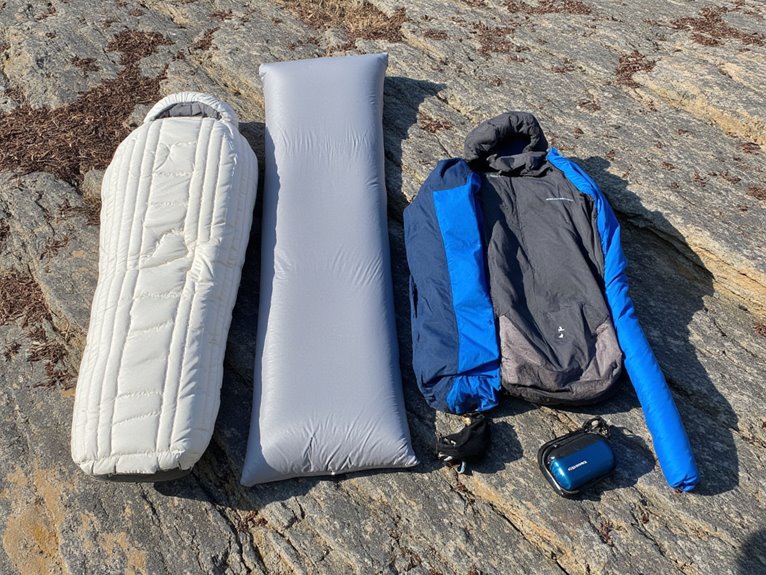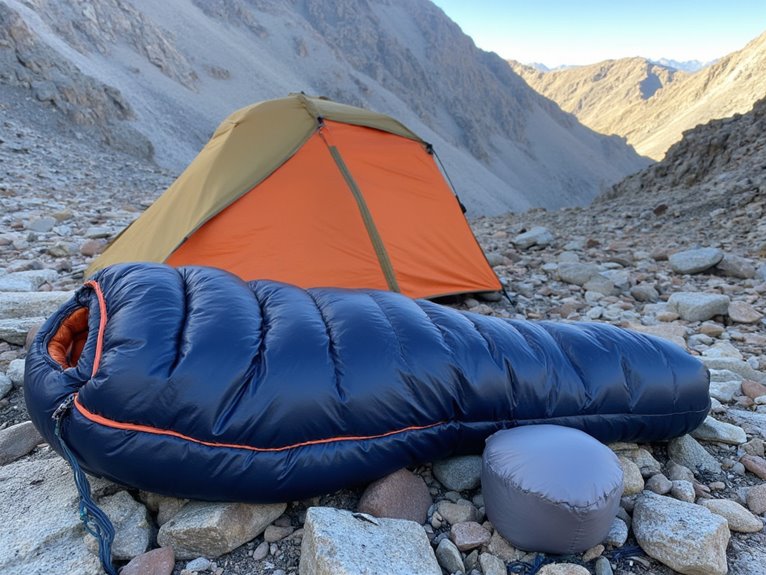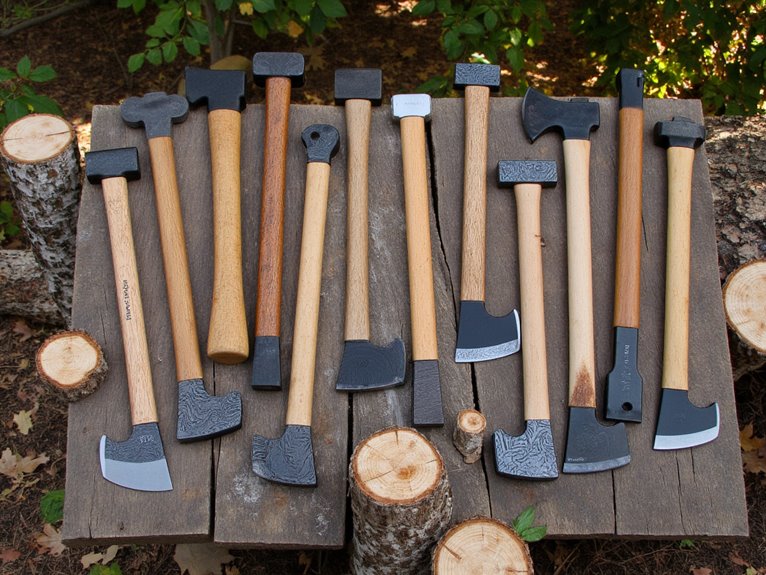Ultralight Backpacking Sleep Systems: Cutting Ounces, Not Warmth
Replace traditional sleeping bags with quilts to shed 8-12 ounces while maintaining warmth through proper pad integration. Choose high-fill-power down (900+) for maximum thermal efficiency, weighing just 1.5-2 pounds for complete systems. Optimize your setup by using clothing as supplemental insulation and selecting seasonal-specific gear with appropriate EN/ISO temperature ratings. Match insulation types to conditions—down above 20°F, synthetic for wet environments. Strategic component selection and system integration release significant weight savings without compromising performance or comfort.
We are supported by our audience. When you purchase through links on our site, we may earn an affiliate commission, at no extra cost for you. Learn more. Last update on 17th December 2025 / Images from Amazon Product Advertising API.
Notable Insights
- High-fill-power down (900+) delivers maximum warmth-to-weight ratio, averaging 1.5-2 pounds for excellent thermal efficiency.
- Replace sleeping bags with quilts to save 4-8 ounces while maintaining warmth through proper pad integration.
- Match insulation to conditions: down above 20°F, synthetic for wet environments to optimize performance without weight penalty.
- Choose inflatable pads with high R-values (4.0+) weighing 12-20 ounces for essential ground insulation and comfort.
- Integrate clothing layers as supplemental insulation and eliminate redundancies like dedicated pillows to reduce system weight.
Materials and Technology That Make the Difference
When you’re selecting an ultralight sleep system, the materials and technology determine whether you’ll carry unnecessary weight or achieve ideal warmth-to-weight performance.
Down insulation remains the gold standard for ultralight applications. High-fill-power down (900+) delivers maximum loft per ounce, creating superior thermal efficiency. Synthetic insulation offers reliable performance in wet conditions and costs less than premium down.
Premium 900+ fill-power down maximizes warmth-to-weight ratios, while synthetic alternatives provide moisture resistance at lower costs.
Ultralight fabrics like Pertex Quantum weigh under one ounce per square yard while maintaining durability.
Ripstop nylon construction prevents tear propagation without weight penalties. Breathable coatings allow moisture vapor transfer while blocking wind infiltration.
Advanced baffle designs prevent fill migration and eliminate cold spots. Hydrophobic treatments on down maintain loft when exposed to humidity.
These material innovations enable sleeping bags under two pounds while providing three-season comfort ratings.
Modern sleeping pads utilize durable 40D ripstop nylon materials that compress to the size of a water bottle while maintaining excellent puncture resistance for rugged terrain use.
Weight Reduction Strategies for Your Sleep Setup

Although premium materials create the foundation for ultralight sleep systems, strategic weight reduction requires systematic evaluation of every component in your setup.
Replace traditional sleeping bags with quilts or top bags to eliminate unnecessary bottom insulation that compresses under your weight. These designs reduce weight by 8-12 ounces while maintaining thermal efficiency.
Consider insulation types carefully. Down offers superior warmth-to-weight ratios at 750-900 fill power. Synthetic alternatives like Climashield APEX provide consistent performance in wet conditions at slightly higher weights.
Optimize your layering strategy by using base layers and mid-layers as supplemental insulation rather than carrying heavier gear. Choose seasonal-specific equipment—don’t pack winter-rated gear for summer trips.
Finally, eliminate redundant items like stuff pillows when your spare jacket serves the same function.
For maximum packability, quality compression sacks can reduce your sleep system dimensions to approximately 11 x 6.3 inches, preserving valuable backpack space for other essential gear.
Essential Components of an Ultralight Sleep System
After implementing weight reduction strategies across your entire setup, you’ll need to understand how each component functions within your complete sleep system.
Your sleeping bag options include down-filled models averaging 1.5-2 pounds with superior warmth-to-weight ratios, or synthetic alternatives that maintain insulation when wet.
Down-filled sleeping bags deliver exceptional warmth-to-weight performance at 1.5-2 pounds, while synthetic options excel in wet conditions.
Quilts eliminate zippers and bottom insulation, reducing weight by 4-8 ounces while requiring proper pad integration.
Pad selection determines ground insulation effectiveness. Inflatable pads offer R-values from 2.5-6.5 while weighing 12-20 ounces. Self-inflating models provide consistent performance but add weight. Closed-cell foam pads weigh just 8-14 ounces but sacrifice comfort.
Ultralight pillows add 2-4 ounces with adjustable firmness. Sleeping bag liners increase warmth ratings by 5-15°F.
EN/ISO temperature ratings guarantee proper insulation selection for expected conditions.
Compression sacks can reduce your sleeping bag’s packed size by up to 40%, often compressing to water bottle dimensions for maximum portability.
Optimizing Your System for Different Conditions
Since environmental conditions directly impact your sleep system’s effectiveness, you’ll need to modify your setup based on temperature, humidity, wind exposure, terrain type, and elevation changes.
Effective temperature management starts with selecting insulation types matched to expected ranges. Down provides superior warmth-to-weight ratios above 20°F, while synthetic fills perform better in wet conditions. Layer your insulation using clothing and sleeping bag combinations for precise thermal control.
Humidity control requires breathable materials that prevent condensation buildup. Choose sleeping bags with water-resistant shells and vapor-permeable fabrics. Position your tent to maximize airflow while maintaining wind protection.
For varied terrain, select inflatable pads with appropriate R-values. Rocky surfaces demand puncture-resistant materials, while sandy conditions need secure anchoring systems. Adjust your setup’s packability based on distance and elevation gain requirements.
For summer conditions, prioritize sleeping bags with temperature ratings between 50°F to 77°F to prevent overheating while maintaining adequate warmth during cooler nights.
Balancing Performance and Comfort in Ultralight Designs
The tension between minimal weight and adequate performance defines every successful ultralight sleep system decision. You’ll face critical trade-offs when selecting comfort features versus weight savings.
The NeoLoft sleeping pad exemplifies this balance with its 4.6-inch thickness and side rails that cradle your body, yet maintains reasonable weight for ultralight pursuits. Stretch knit polyester materials conform closely to your body shape while adding minimal ounces.
Effective insulation techniques determine system success in varying conditions. High R-value pads like the NeoLoft’s 4.7 rating provide adequate thermal protection without excessive bulk.
You can enhance warmth through system integration—combining lightweight sleeping bags with closed-cell foam additions for extreme conditions. Smart material selection, such as 50-denier polyester fabrics, guarantees durability without weight penalties.
Every component must justify its inclusion through measurable performance gains. For backpacking efficiency, choose pads weighing between 3-8 pounds to optimize the balance between comfort and weight savings.



